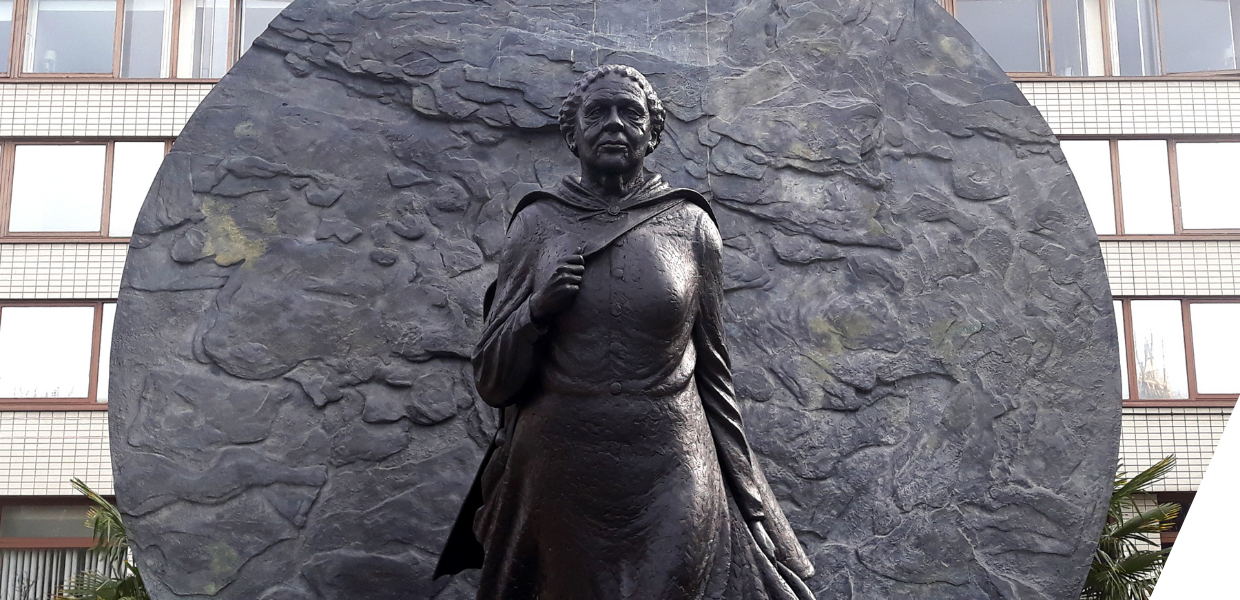Thank you for sharing inVISIBLEwomen with us! Can you tell us a bit more about the initiative?
inVISIBLEwomen is a campaign for gender equality in civic statues in the UK; a meeting place for supporters of greater representation of real women - not just symbolic ‘nymphs’ and ‘angels’ - in our parks, town centres and city streets, and for sharing ways that can be achieved.
It’s needed because the figures we are asked to ‘look up to’, both literally and figuratively, in our civic spaces have an influence on how we perceive the value of both women and men. If we never see any real women’s achievements celebrated, we are led to believe that they are simply not capable.
What inspired you to start the project?
inVISIBLEwomen came into being in 2016 after I saw the London memorial to women who served in World War II. It took a while for me to realise what it was, because there were no women in it, just their empty uniforms hung around the plinth. That might have been quite poignant: illustrating the loss of life, but, when compared to the great mass of statues of male soldiers in the city, all fully physically present, it is a perfect illustration of the way in which women continue to be rendered invisible in our society.
Seeing this ‘memorial' to women made me consider how women are represented in UK civic statues. Some research confirmed my perception that men are vastly over-represented: the latest available figures (2016) show that about 85% of statues are male and 15% female, of which 12% were nameless ‘symbolic’ figures with only 3% commemorating real women for their achievements. So that’s 3% to represent 50% of the population.
How have you raised awareness of the initiative?
I have acted locally, nationally and internationally and have forged links with a number of campaigns. I am one of the ambassadors for the Mary Clarke statue campaign in Brighton and I have had a presence at WOW, the London Women of the World Festival, for three years. I have been part of the Audacious Women Festival in Edinburgh and run workshops for university students and the public from Aberdeen to Basingstoke. I have written articles for magazines including the Women’s Institute publication, been interviewed for local TV and national BBC radio and quoted in national newspapers.
Internationally, inVISIBLEwomen is a member of the International Association of Women’s Museums. I ran a workshop ‘Civic Statues in Istanbul; A Gender Mapping’ at their 2018 conference in Istanbul, which is detailed in their subsequent publication ‘Feminist Pedagogy: Museums, Memory Sites and Practices of Remembrance’.
I also share regular posts on the site and social media about new campaigns, statues unveiled, national and international news stories about civic statues and their uses and the increasing public understanding of their quiet, persistent power. Supporters of the initiative are sent an Annual Update, featuring analysis of various cultural phenomena in that year.
What results has the project had?
Since 2016 I have seen major changes in how statues in the UK are perceived. Notably, two major cultural associations - the Public Statues and Sculptures Association and Art UK - have both developed awareness of the issue and now have created dedicated sections on their sites for statues of women.
Working on the available figures, there has been an astonishing improvement in the rate of women’s statues being erected. From the late 1800s until 2016, an average of 0.6 statues of women were raised each year. From 2016 to 2021, six statues were erected of women each year - a ten-fold increase. This goes only a small way to correct the huge imbalance, but is a significant shift in attitudes and these memorials to women have been exceptionally well received by the public. Statues have really been in the news over the past few years and their influence is becoming better understood.
Have there been any significant developments in your work in 2022?
I have run inVISIBLEwomen alone since 2016. This year, however, I am pleased to say that I have been joined on the site by a group of active, experienced campaigners for statues of women in the UK - each has a place on the new page, ‘VISIBLEWomenUK’ with links to their sites. They provide mutual support, sharing experience and advice about how to overcome the many obstacles placed in the way of memorials for women. Both new and existing campaigns are very welcome to join. The joint aim with the VISIBLEwomen group is to celebrate the great women of the past to inspire the great women of the future.
What advice would you give to someone who wanted to start a similar initiative to highlight women’s history in their own country or area?
If there is any public interest/publicity about the issue, that is a good place to start. For example in Italy there has recently been a debate over just one statue of a woman being added to a group of 78 men and another row over a sexualised image of a woman purporting to illustrate a poem. Check if there are any influential public figures who would be willing to support the initiative. A famous name is always helpful. Look at campaigns in other countries, they are happening all over the world, all aiming to pass on these untold histories on to the future.
Find out more
Find out more about inVISIBLEwomen and explore Europeana’s blog on statues of women throughout Europe.
Readers based in the UK can hear from the inVISIBLE women project at the workshop ‘Women & Sculpture: New Histories and Futures’ on 17 June 2022 at the Laing Art Gallery in Newcastle-upon-Tyne. Find out more and register.



